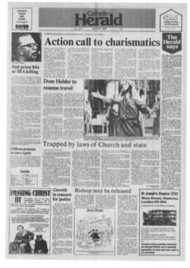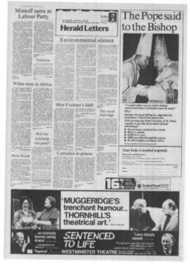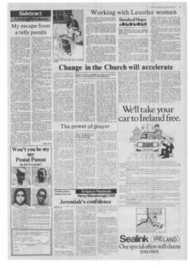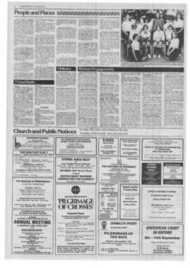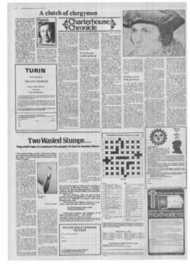Page 10, 23rd June 1978
Page 10
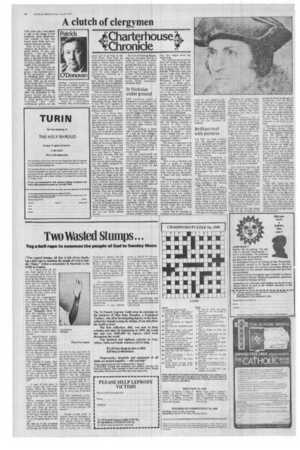
Report an error
Noticed an error on this page?If you've noticed an error in this article please click here to report it.
Tags
Share
Related articles
A Deanery Answer To Parish Problems
No Vin-ordinaire I Am Delighted To See That A Book Is
How The Other Half Works Machinery Of Canon Law
I Might Not Be A Good
Charterhouse Chronicle
A clutch of clergymen
4Charterhouse1 Chronicle THE other day I was asked to talk to the clergy of two Anglican rural deaneries. The trouble is that one learns more from such occasions than one teaches.
First of all they met to celebrate the Eucharist in the parish church. To that, very properly. I was not invited. Then they met, about 20 of them, in the church hall where Devoted Women served a sort of clerical coffee with sensible, middle of the road biscuits.
Though their clothes are the same as those of Catholic priests the Catholics tend to be less conventional there is no mistaking them. They are quiet and courteous and civilised men. They are all worried about money and if they keep whisky in the house it is strictly for medicinal purposes.
They are adept at small talk. They arc fascinated by the Roman Church and are, in practice, greatly influenced by U. They gossip less than
Catholics and their ecclesiastical politics are less thrilling perhaps because no one can be sacked except for proven moral turpitude and they all sit on committees and worry about the size of their congregations. the uncertain Fabric of their churches and the role of the Church in society. Theirs is a remarkable freedom. They can be as idle as
pussy cats or as busy as the Cure d'Ars. They have an assured place in society which, I suspect, leaves them rather lonely, for they are neither of the gentry nor of the working classes and they do not claim quite the same degree of sacramental authority as a Catholic priest.
They can, and often do, snap their fingers at their bishops. But they also have an elaborate apparatus of wardens and councils to be placated. They have to do a lot of extra, secular work.
They are usually married and their wives have to work quite as hard as they do and some of their necessary work must be screamingly boring. They seem to have far more organists at their disposal than we do and there is almost always someone difficult in their choir.
They worry about their liturgy and we had quite a discussion about it in question time. I was loyal about ours and they knew more about it than I did about theirs. The consensus was that they did not much like any changes in their prayerbook and would like to go back to Cranmer's Book of Common Prayer.
The morning I spoke I saw a report that some organisation called the Protestant Reformation Society I think had complained about the growing practice of having the Romans in to sing Mass or Vespers in their great churches, This was described as "Catholic aggression." The clergy I was with entirely approved the practice and indeed hungered for inter-communion.
When we had done, they did not stop for sherry or for the slap-up meat and two veg that the Catholics might have laid on. They got into their tiny cars, they twinkled at each other and drove carefully back to their over-large and under-furnished houses. I found them flatteringly kind, very tolerant and highly civilised. They are an essential element in society. They really are good men and it is well for us to recall this.
One thing, though. At the end in a vote of thanks one described me as being "as eloquent as a Welsh bishop." What could he mean? Did I overdo it? There arc very few Welsh bishops anyway. Our own Archbishop Murphy (and you can guess what he is called behind his back) writes brilliant pastoral letters, perhaps the best in the country. Bishop Langton Fox of Menevia is a scholar, But I am sure he was not comparing me to them. The remark has stuck like a barb. As eloquent as a Welsh bishop indeed! It sounds wordy, showy, emotional, theatrical. It fits.
St Nicholas
under ground
THE Candover valley in Hampshire is named after a tiny stream that creeps through it. It contains some great square Cromwellian farm houses, some of the finest farms in England and the villages of Preston Candover, Chilton Candover and Brown Candover. It is the sort of green place with great heavy trees and rich hedges and everything under control that exiles dream of.
Chilton Candover is rather odd. It consists of the big house on a hill; the farm manager's house which is large enough for any stockbroker and the old vicarage which is a mansion and that is all. (There are cottages, but not in any village sense). In a sloping meadow there are a few old gravestones and a buried church.
This was rediscovered and excavated only 50 years ago. An old man kept losing his ferrets down a large hole and, digging, found steps which led down to a small yard in front of this minuscule church.
This had probably been built soon after the Conquest. It has a narrow chancel arch and a little rounded sanctuary and a vaulted roof. It contains a large shaped stone coffin with a recess cut to hold the head and a small one for a child.
There is a fine purbeck marble font and two grave slabs with floreate crosses on them that once probably covered the graves of priests. One of them has inscribed on it in Lombardic script, "Here lies John of Candover. God have mercy on his soul." There used to be a 14th century church on top of it, but they pulled it down because nobody wanted it and then they foigot about the whole thing.
They had their annual service there last Sunday evening. On the flat roof of the chapel they had set up an altar, There was a lady pringling away on a har monium. There was a choir, the vicar in a cope, some sidesmen, a young man running a loudspeaker and the Bishop of Winchester splendid in lawn sleeves and a scarlet gown. There were several hundred in the congregation on the grass.
It was quite extraordinary. It was a still, hot, brilliantly lit evening. Behind the church is a semicircle of great trees arranged for a Midsummer Night's Dream. And in front of it all was the wide, rich valley, gently shaped, with ripe fields and uninsistent lanes, more graceful than a park, an almost unfair epitome of England.
So our thin hymns rose in the evening sunlight. The Squire read a lesson, so did his son-in
law. The Bishop preached a sermon of 18th century
elegance and 20th century length about the undiscovered goodness of people which made a change from sin. I have never attended a m..,re enchanted English occasion. It was good to be there.
The church is dedicated to St Nicholas, who used to have more churches than anyone in the country, except Our Lady. I once went to his own church on the coast of Turkey at a place called Dembre which used to be Myra.
There is not a Christian left within a couple of hundred miles of it. But there is a small church, ruinous, the old Byzantine frescoes falling off the walls. That one too, only slightlylarger, had been buried by time. St Nicholas's stone tomb was there in a recess, but empty, looted I believe by the Genoese. That was a sad and desolate place with the ruin of a Byzantine city on a hillside, a huge Victorian and roofless warehouse beside a silted river which had an inscription to the Emperor Hadrian on its facade and a depressed and very lonely Turkish village. But the feeling of the two churches was astonishingly the same.
Except that St Nicholas in Candover is alive and loved and
cared for and visited by fortunate people while St Nicholas in Myra is picked at by hostile Turks and otherwise ignored and is dying. If you are ever driving out from Basingstoke or Winchester, you ought to try to see this one. It's as good a place as I know in which to thank God for the mystery of England.
Brilliant tool with pictures
I'M NOT the book reviewer here. But someone has given me an admirable new introduction to St Thomas More. It's by Gordon Rupp, clear, concise and sensible. It's published by Collins at £4.95. Now I can get on with my thing. It is most sumptuously illustrated. I cannot think of any work of history that has been better illustrated. The pictures become an integral part of the story and surely bench-work photography has never been better.
Most of the pictures are new to me. There is one of Henry VII looking as sly as Nixon but more intelligent with nervous fingers clutching a sill.
There are several of Henry VIII, who was described as a most beautiful and brilliant youth. Here, even in his thirties, he has the face and mien of a saloon bar bore and bully. If he starts telling a story you are made to stay to the end, even if he has to put a finger in your buttonhole. He has the face of one who was once a major and never got over the glory of it.
Catherine of Aragon looks stiff and dull and clearly has Tridentine tendencies. Luther, on the other hand. looks witty and enchanting, like a licensed wit at an Oxford High Table who knows just when to stop drinking port.
Poor Cranmer h as a melancholy downturned mouth and vast eyes. He would look well as a moral protester against almost anything that happened to do his country good. He looks the born defector of in tense and vain integrity.
The Popes are not so good, though their portraits are the more brilliant. Indeed they dazzle with their honesty. One is astonished at the confidence of allowing such revealing selfikons. There is Clement VII who refused the royal divorce, very good looking but with a slightly sinister sneer, A frightening prince, I would have thought, not as much fun as Luther but far more intelligent.
Then there is Pope Paul III with two "nephews" both cardinals. He nominated John Fisher, Bishop of Rochester, a cardinal, and, though the Red Hat is meant to be a symbol of a willingness for martyrdom, St John of Rochester, the poorest diocese in England, is the only one I can think of that got it.
Pope Paul looks old and very bent and cunning. The trouble is that these portraits are so great and their Holinesses were so fastidious that they did not do a Winston Churchill and destroy their likenesses, There is also Pope Leo X.
He was the one who raised funds for the building of the
present St Peter's by the issue of Indulgences. That set Martin Luther off. It's a great face, but I'd rather go a couple of rounds with our new Papal Knight, Henry Cooper, than with him. But can you judge people by
their faces? Someone wrote that by the age of 40 you have yourself written your life and character on the front of your skull.
Then there are the portraits of Thomas More. They astonish. The long commanding nose. The slightly unshaven jowls, (Mr Gillette had not been born.) The gravltas that looks as if he would yet be enchanting to entertain at dinner because he would talk both in turn, and well. The terrible, almost El Greco scrawl of a portrait of him in prison holding the little red cross that he carried to his scaffold and death is a shocking revelation. It is owned by a descendant.
He was painted often because he was in a secular sense so important a man. I found a strong portrait of him in the Prado in Madrid when, by the Grace of God, my plane had been grounded for 24 hours during a trip to some dull place in Africa.
Very well. Faces are only facades. "1 met Death when out one day, and he had a face like Castlereagh.But More's face is an addition to the dignity of the human race. I fear this is not the Marxist view of history or the Vatican appraisal of personal sanctity. But this book adds to your understanding of the great time in our history and of the great man set like a sensible jewel into it.
blog comments powered by Disqus


